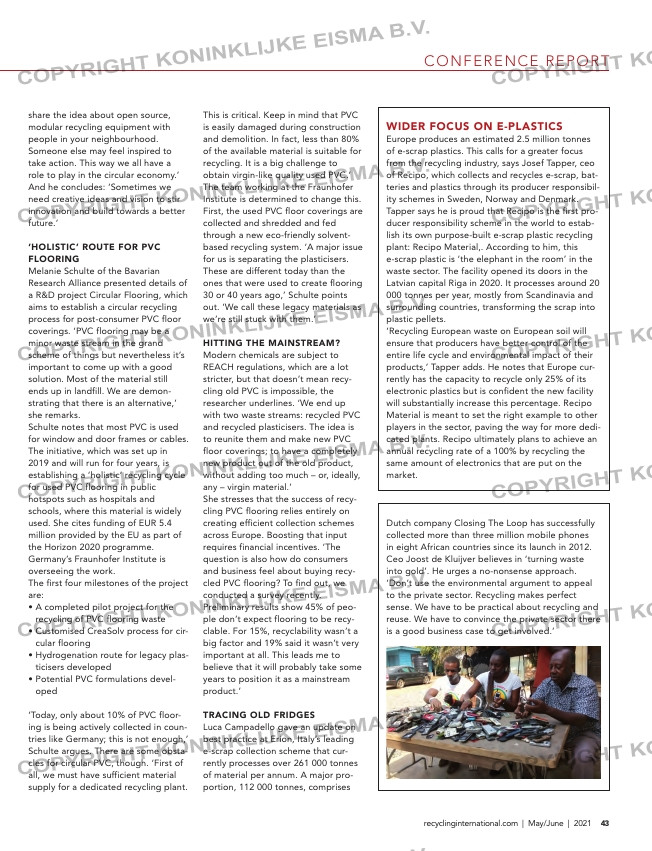Page 43 from: Recycling International May issue | 2021

CONFERENCE REPORT
43recyclinginternational.com | May/June | 2021
share the idea about open source,
modular recycling equipment with
people in your neighbourhood.
Someone else may feel inspired to
take action. This way we all have a
role to play in the circular economy.’
And he concludes: ‘Sometimes we
need creative ideas and vision to stir
innovation and build towards a better
future.’
‘Holistic’ route for PVc
flooring
Melanie Schulte of the Bavarian
Research Alliance presented details of
a R&D project Circular Flooring, which
aims to establish a circular recycling
process for post-consumer PVC floor
coverings. ‘PVC flooring may be a
minor waste stream in the grand
scheme of things but nevertheless it’s
important to come up with a good
solution. Most of the material still
ends up in landfill. We are demon-
strating that there is an alternative,’
she remarks.
Schulte notes that most PVC is used
for window and door frames or cables.
The initiative, which was set up in
2019 and will run for four years, is
establishing a ‘holistic’ recycling cycle
for used PVC flooring in public
hotspots such as hospitals and
schools, where this material is widely
used. She cites funding of EUR 5.4
million provided by the EU as part of
the Horizon 2020 programme.
Germany’s Fraunhofer Institute is
overseeing the work.
The first four milestones of the project
are:
• A completed pilot project for the
recycling of PVC flooring waste
• Customised CreaSolv process for cir-
cular flooring
• Hydrogenation route for legacy plas-
ticisers developed
• Potential PVC formulations devel-
oped
‘Today, only about 10% of PVC floor-
ing is being actively collected in coun-
tries like Germany; this is not enough,’
Schulte argues. There are some obsta-
cles for circular PVC, though. ‘First of
all, we must have sufficient material
supply for a dedicated recycling plant.
This is critical. Keep in mind that PVC
is easily damaged during construction
and demolition. In fact, less than 80%
of the available material is suitable for
recycling. It is a big challenge to
obtain virgin-like quality used PVC.’
The team working at the Fraunhofer
Institute is determined to change this.
First, the used PVC floor coverings are
collected and shredded and fed
through a new eco-friendly solvent-
based recycling system. ‘A major issue
for us is separating the plasticisers.
These are different today than the
ones that were used to create flooring
30 or 40 years ago,’ Schulte points
out. ‘We call these legacy materials as
we’re still stuck with them.’
Hitting tHe mainstream?
Modern chemicals are subject to
REACH regulations, which are a lot
stricter, but that doesn’t mean recy-
cling old PVC is impossible, the
researcher underlines. ‘We end up
with two waste streams: recycled PVC
and recycled plasticisers. The idea is
to reunite them and make new PVC
floor coverings; to have a completely
new product out of the old product,
without adding too much – or, ideally,
any – virgin material.’
She stresses that the success of recy-
cling PVC flooring relies entirely on
creating efficient collection schemes
across Europe. Boosting that input
requires financial incentives. ‘The
question is also how do consumers
and business feel about buying recy-
cled PVC flooring? To find out, we
conducted a survey recently.
Preliminary results show 45% of peo-
ple don’t expect flooring to be recy-
clable. For 15%, recyclability wasn’t a
big factor and 19% said it wasn’t very
important at all. This leads me to
believe that it will probably take some
years to position it as a mainstream
product.’
tracing old fridges
Luca Campadello gave an update on
best practice at Erion, Italy’s leading
e-scrap collection scheme that cur-
rently processes over 261 000 tonnes
of material per annum. A major pro-
portion, 112 000 tonnes, comprises
Fotobijschrift
KaderKoP
??
Dutch company Closing The Loop has successfully
collected more than three million mobile phones
in eight African countries since its launch in 2012.
Ceo Joost de Kluijver believes in ‘turning waste
into gold’. He urges a no-nonsense approach.
‘Don’t use the environmental argument to appeal
to the private sector. Recycling makes perfect
sense. We have to be practical about recycling and
reuse. We have to convince the private sector there
is a good business case to get involved.’
Wider focus on e-Plastics
Europe produces an estimated 2.5 million tonnes
of e-scrap plastics. This calls for a greater focus
from the recycling industry, says Josef Tapper, ceo
of Recipo, which collects and recycles e-scrap, bat-
teries and plastics through its producer responsibil-
ity schemes in Sweden, Norway and Denmark.
Tapper says he is proud that Recipo is the first pro-
ducer responsibility scheme in the world to estab-
lish its own purpose-built e-scrap plastic recycling
plant: Recipo Material,. According to him, this
e-scrap plastic is ‘the elephant in the room’ in the
waste sector. The facility opened its doors in the
Latvian capital Riga in 2020. It processes around 20
000 tonnes per year, mostly from Scandinavia and
surrounding countries, transforming the scrap into
plastic pellets.
‘Recycling European waste on European soil will
ensure that producers have better control of the
entire life cycle and environmental impact of their
products,’ Tapper adds. He notes that Europe cur-
rently has the capacity to recycle only 25% of its
electronic plastics but is confident the new facility
will substantially increase this percentage. Recipo
Material is meant to set the right example to other
players in the sector, paving the way for more dedi-
cated plants. Recipo ultimately plans to achieve an
annual recycling rate of a 100% by recycling the
same amount of electronics that are put on the
market.
42-43-44-45-46-47_circularmaterials.indd 43 10-05-21 14:30



